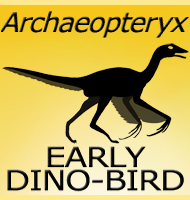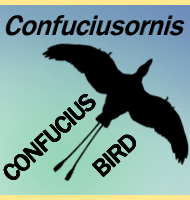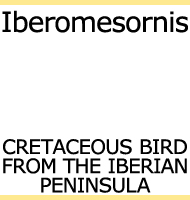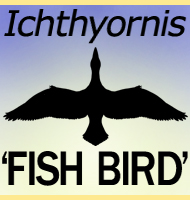


Yixianornis
Name:
Yixianornis
(Yixian bird).
Phonetic: Yiks-e-an-or-niss.
Named By: X. Zhou & F. Zhang -
2001.
Classification: Chordata, Aves,
Yanornithiformes, Songlingornithidae.
Species: Y. grabaui (type).
Diet: Uncertain.
Size: About 20 centimetres long, 40
centimetre wingspan.
Known locations: China, Liaoning Province -
Jiufotang Formation.
Time period: Aptian of the Cretaceous.
Fossil representation: Complete individual preserved
on a slab which includes clear impressions of the feathers.
Yixianornis
clearly differs from most other early Cretaceous birds in that the
wings are rounded instead of pointed. The tail of Yixianornis
is
also clearly formed into a pygostyle which allowed for a strong and
flexible attachment for tail feathers, which could be fanned out in
flight, and then packed tight when resting. Altogether the form of
the wings of Yixianornis indicate that this was a
bird that was much
closer to modern forms than other early Cretaceous birds such as
Confuciusornis.
The wings also indicate that Yixianornis
was flying
amongst densely overgrown areas such as forests where space was
limited. By having short but broad wings, Yixianornis
could avoid
unnecessary damage to the wings from brushing against branches and tree
trunks. Such wing proportions are still seen in modern birds that
frequent forested habitats.
Yixianornis
was likely a strong flyer, with the hand bones fused together for
greater strength during a flight stroke, while the breast bone has a
strong keel allowing for the attachment of larger pectoral muscles,
allowing for stronger prolonged flapping flight. Yixianornis
still
had some primitive feature however, the most obvious of which is the
presence of small peg like teeth in the mouth. Most of these teeth
seemed to have been packed to the rear of the mouth, particularly
in the lower jaw, while the anterior (front) tips of the mouth
are lacking any teeth but have pitting. This may indicate that
Yixianornis had developed a rudimentary beak that
covered the forward
portion of the mouth.
Further reading
- Two new ornithurine birds from the Early Cretaceous of western
Liaoning, China. - Chinese Science Bulletin
46(15):1258-1264. - X. Zhou & F. Zhang -
2001.
- Insight into the evolution of avian flight from a new clade of
Early Cretaceous ornithurines from China and the morphology of
Yixianornis grabaui. - Journal of Anatomy,
208(3):
287-308. - J. A. Clarke, Z. Zhou & F. Zhang
- 2006.
----------------------------------------------------------------------------
Random favourites
 |
 |
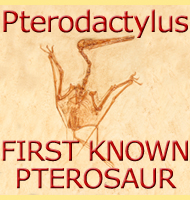 |
 |
